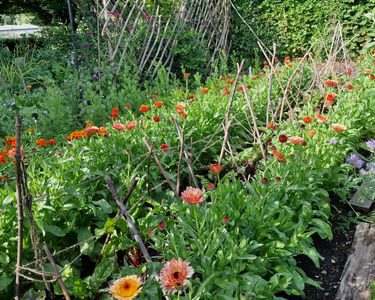Best ways to harness the power of flowers

Plants work better when mixed together, and this is true even in your veg patch. It’s a constant balance in an organic space between pests and predators. You try to limit your interference to allow nature to do its thing, while giving them a helping hand.
In recent years we’ve been using a form of companion planting in our veg patch, with great results. Like many gardeners, we often filled empty spots with flowers or herbs - but now we plan our potager around the flowers instead of the produce.
Flowers are chosen based on three criteria; their ability to attract predators and pollinators; their size and shape (you don’t want flowers that will out-compete or shade the produce); and of course, how good they look.
We use nigella, calendula, marigolds and snapdragons, at various heights, all with single flowers that are more accessible for pollinators. But there are lots to choose from.
The results are impressive. Last year, the calendula supported the chickpeas allowing them to scramble through the flowers, and encouraged plenty of pollinators. Pests such as aphids were reduced on the crops, thanks to plenty of predators visiting the garden.
Here's some more classic combinations to try:
- Calendula and cabbage. Insects such as hoverflies and ladybirds will be attracted to the flowers and act as predators to the brassica-loving cabbage white caterpillar.
- Nasturtiums and beans. Juicy nasturtium leaves and their brightly coloured flowers pull blackfly away from your beans, and once there they will tend to stay on the host plant.
- Marigolds and tomatoes. Plant orange/yellow marigolds in greenhouse beds to attract whiteflies away from the tomato plants. It’s not the smell that confuses the pests, but they’re attracted to the colourful petals.
- Lettuce and sweetcorn. Divert slugs to a sacrificial row of salad between your corn cobs so they munch on that rather than your prized crops.
- Crimson clover and fruit trees. Grow strips of clover between fruit trees or bushes. If mown regularly, the cuttings can be thrown under the bushes, where the nitrogen-rich leaves break down quickly to supply nutrients to the trees.